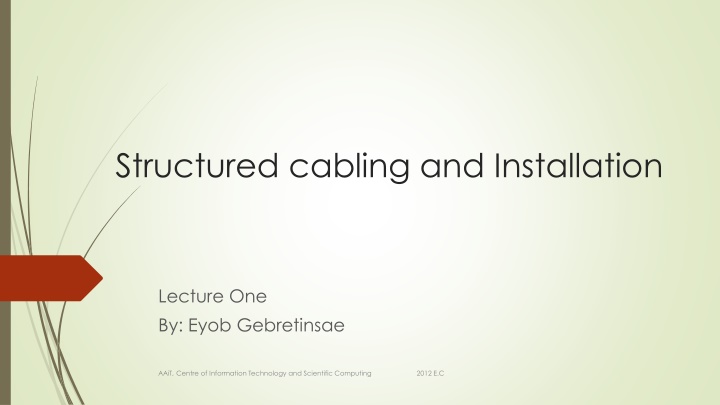Structured Cabling and Installation Overview
"Structured cabling involves designing and installing a system to support various hardware needs efficiently. This lecture covers the importance, standards, and types of cables used, such as twisted pair cables and coaxial cables. Learn about copper cables, Ethernet technology, and shielded vs. unshielded twisted pair configurations for optimal data transmission."
Download Presentation

Please find below an Image/Link to download the presentation.
The content on the website is provided AS IS for your information and personal use only. It may not be sold, licensed, or shared on other websites without obtaining consent from the author.If you encounter any issues during the download, it is possible that the publisher has removed the file from their server.
You are allowed to download the files provided on this website for personal or commercial use, subject to the condition that they are used lawfully. All files are the property of their respective owners.
The content on the website is provided AS IS for your information and personal use only. It may not be sold, licensed, or shared on other websites without obtaining consent from the author.
E N D
Presentation Transcript
Structured cabling and Installation Lecture One By: Eyob Gebretinsae AAiT, Centre of Information Technology and Scientific Computing 2012 E.C
Data Cables Contents Introduction Copper Cables Twisted Pair Cables Coaxial Cables AAiT, Centre of Information Technology and Scientific Computing 2012 E.C
Introduction Structured cabling is the design and installation of a cabling system that will support multiple hardware uses and be suitable for today s needs and those of the future. With a correctly installed system, current and future requirements can be met, and hardware that is added in the future will be supported Structured cabling design and installation is governed by a set of standards that specify wiring data centers, offices, and apartment buildings for data or voice communications AAiT, Centre of Information Technology and Scientific Computing 2012 E.C
Cable is the medium through which information usually moves from one network device to another. There are several types of cable which are commonly used with LANs. The type of cable chosen for a network is related to the network's topology, protocol, and size. AAiT, Centre of Information Technology and Scientific Computing 2012 E.C
Coper Cables/Twisted Pair Cables Twisted pair cabling is a type of wiring in which two conductors of a single circuit are twisted together for the purposes of improving electromagnetic compatibility. Twisted pair cables have become a standard in data networks These types of cables are characterized by their low cost, flexibility and ease of installation, as well as constant technological improvements. Alexander Graham Bell, popularly known as the inventor of the telephones, was the first person to twist copper pairs to reduce crosstalk between the lines. AAiT, Centre of Information Technology and Scientific Computing 2012 E.C
Ethernet copper cables adopted the same technique to reduce crosstalk between internal wires (XT) and external wires (AXT). Each pair is twisted with a different number of twists per inch to help eliminate interference from adjacent pairs and other electrical devices. The tighter the twisting, the higher the supported transmission rate and the greater the cost per foot. AAiT, Centre of Information Technology and Scientific Computing 2012 E.C
Shielded (FTP) vs. Unshielded (UTP) Twisted pair copper comes in shielded an unshielded forms. Shielded copper cable includes protective conductive coating such as braided strands of copper, copper tape or conductive polymer to reduce noise interference. AAiT, Centre of Information Technology and Scientific Computing 2012 E.C
Shielded copper pairs There are many types of shielded copper pairs. Sheathing can also envelop all four data pairs. Sheathing can wrap around twisted pairs. There are two sections to a shielded code . The first letter signifies the type of shield used to enclose all four twisted pairs of an Ethernet cable. AAiT, Centre of Information Technology and Scientific Computing 2012 E.C
Unshielded Twisted Pair, or UTP, includes no shielding and is ideal for most common LAN environments Shielded twisted copper pairs, are reserved for networking environments with higher frequencies. Shielded cables can also help to extend the maximum distance of the cables. An Unshielded cable is marked with a (U), a cable with Foil Shielding is marked with an (F), and a cable with Braided Shielding is marked with an (S). The second portion of the code, describes if a twisted pair is foiled (F) or Unfoiled (U). TP stands for Twisted Pair. AAiT, Centre of Information Technology and Scientific Computing 2012 E.C
Types of Shielded Ethernet Cables F/UTP Foiled/Unshielded Twisted Pair Common in Fast Ethernet deployments, this cable will have a foil shield that wraps around unshielded twisted pairs. S/UTP Braided Shielding/ Unshielded Twisted Pair This cable will wrap a braided shield around unshielded twisted pairs. SF/UTP Braided Shielding + Foil/Unshielded Twisted Pairs This cable braids a shield around a foil wrap to enclose unshielded twisted pairs. AAiT, Centre of Information Technology and Scientific Computing 2012 E.C
S/FTPBraided Shielding/Foiled Twisted Pair This cable wraps a braided shield around all four copper pairs. Additionally, each twisted pair is enveloped in foil. F/FTP-Foiled/Foiled Twisted Pair This cable encloses all copper pairs in foil. Additionally, each twisted pair is enveloped in foil. If you must place cable in environments with lots of potential interference, or if you must place cable in extremely sensitive environments that may be susceptible to the electrical current in the UTP, shielded twisted pair may be the solution AAiT, Centre of Information Technology and Scientific Computing 2012 E.C
U/FTP-Unshielded/Foiled Twisted Pairs This cable only envelopes the twisted pairs in foil. U/UTP-Unshielded/Unshielded Twisted Pair No sheathing is used. Standard Cat5e cable are examples of U/UTP cables. It may be susceptible to radio and electrical frequency interference (it should not be too close to electric motors, fluorescent lights, etc.). AAiT, Centre of Information Technology and Scientific Computing 2012 E.C
Category 3 Cat3 cable is an earlier generation of Ethernet With the ability to support a maximum frequency of 16 MHz, this type of Ethernet can still be used for two line telephone systems and 10BASE-T networks. CAT3 cable can also be used for alarm system installation or similar applications. CAT3 cable can have 2, 3, or 4 copper pairs (though uncommon). AAiT, Centre of Information Technology and Scientific Computing 2012 E.C
Category 5 and Category 5e Cat5 Ethernet, introduced 10/100 Mbps Ethernet over distances of up to 100 meters, also known as Fast Ethernet Though Cat5 and Cat5e cables are physically similar, Category 5e Ethernet adheres to more stringent IEEE standards E is for enhanced, meaning a lower-noise version where the potential for crosstalk is reduced AAiT, Centre of Information Technology and Scientific Computing 2012 E.C
Crosstalk is interference that transfers from adjacent wires. Cat 5e supports speeds of up to 1000 Mbps. It s flexible enough for small space installations like residences, though it is still used in commercial spaces. Cat5e is your least expensive option. 100-250Mhz/1 Gbps/100m. Cat5e cable features 1.5-2 twists per cm The amount of twists per cm varies upon each cable manufacturer AAiT, Centre of Information Technology and Scientific Computing 2012 E.C
Category 6 and Category 6a Cat6 wiring can support up to 10 Gbps and frequencies of up to 250 MHz. While Cat5e cable features 1.5-2 twists per cm, Cat6 cables are more tightly wound and feature 2 or more twists per cm. Cat6 cables also sport thicker sheaths in comparison to Cat5e. Though standard Ethernet supports distances of up to 100 meters, CAT6 cable only supports 37-55 meters (depending on crosstalk) when transmitting 10 Gbps speeds. AAiT, Centre of Information Technology and Scientific Computing 2012 E.C
Cat 6 cables are also great Ethernet cables for gaming due to their high data transfer speeds and dependability. 250Mhz /10 Gbps /100m. Cat6a supports bandwidth frequencies of up to 500 MHz, twice the amount of Cat6 cable, and can also support 10Gbps like its predecessor However, unlike Cat6 cabling, Cat6a can support 10 Gigabit Ethernet at 100 meters. The stronger sheathing makes Cat6a cabling considerably thicker than Cat6, also making it less flexible to work with, and therefore, better suited for industrial environments at a lower price point. 250-500Mhz/10 Gbps /100m. AAiT, Centre of Information Technology and Scientific Computing 2012 E.C
Category 7 and Category 8 Cat7 can also support 10 Gbps, but laboratory testing has successfully shown its ability to transmit up to 40 Gb at 50 meters and even 100 Gb at 15 meters Cat7 offers extensive shielding to reduce signal attenuation Both individual pairs are shielded, with an additional layer of shielding over the entire cable. The shielding needs to be grounded and Cat7 also requires special GigaGate45 (GG45) connectors to take full advantage of higher performance features. Cat7 is suited for use in datacenters and large enterprise networks. Note: 600Mhz/10Gbps/100m (40Gbps at 50m/100Gbps at 15m). AAiT, Centre of Information Technology and Scientific Computing 2012 E.C
Cat8 cable is still in the development stage and not yet ratified. it will be able to support 25GB and 40Gb Ethernet. Cat8 will be able to support even faster transmission rates at distances of up to 30 meters. AAiT, Centre of Information Technology and Scientific Computing 2012 E.C
What type of cabling to use once deciding on a CAT types Each cable category has various types of insulation or shielding that installers need to take into consideration before using. The price difference between the various types can range anywhere from $100 to $600+ per roll depending on type. You have to Answer the following type of questions before deciding what type of Cat cable are appropriate for a site AAiT, Centre of Information Technology and Scientific Computing 2012 E.C
Are you looking for burial cables with UV protection? Will the cables be in walls? Is flame resistance cabling required for the installation? What is the minimum speed required in the network infrastructure? What is the distance between the node and the rack? For what purpose dose the cable used for? AAiT, Centre of Information Technology and Scientific Computing 2012 E.C
Coper Cables/Coaxial Cables Coaxial cabling has a single copper conductor at its center. A plastic layer provides insulation between the center conductor and a braided metal shield. The metal shield helps to block any outside interference from fluorescent lights, motors, and other computers. AAiT, Centre of Information Technology and Scientific Computing 2012 E.C
Coaxial cabling is difficult to install, it is highly resistant to signal interference It can support greater cable lengths between network devices than twisted pair cable Coaxial cables are used in high frequency transmission, especially for transmitters and receivers, computers, radio and TV transmissions. AAiT, Centre of Information Technology and Scientific Computing 2012 E.C
Common Types of Coaxial Cable RG6 Solid Copper Coaxial Cable The RG6 cable is a thin cable that can easily be coiled or bent for residential installation within a wall or ceiling. This includes connecting aerial antennas, satellite dishes and cable television. A key benefit of the RG6U cable, and a reason for its popularity, is that it often replaces RG59 cables, an earlier form of coaxial video/audio cable. RG11 Solid Copper Coaxial Cable RG11 coax cable is a thick, inflexible cable used to minimize signal loss in long runs, RG11 is typically run outside or underground. AAiT, Centre of Information Technology and Scientific Computing 2012 E.C
RG59 Solid Copper Coaxial Cable RG59 is another popular cable in residential settings, the RG59 functions similarly to the RG6 but has an even thinner center conductor This difference makes the RG59 the best choice for short runs and low frequency transmissions within the home, but otherwise inferior to the RG6U cable in other applications. AAiT, Centre of Information Technology and Scientific Computing 2012 E.C























